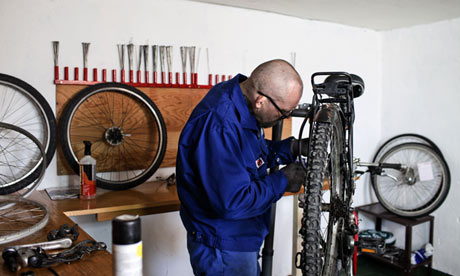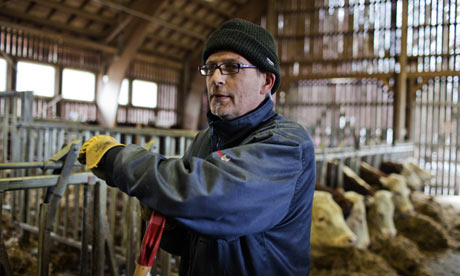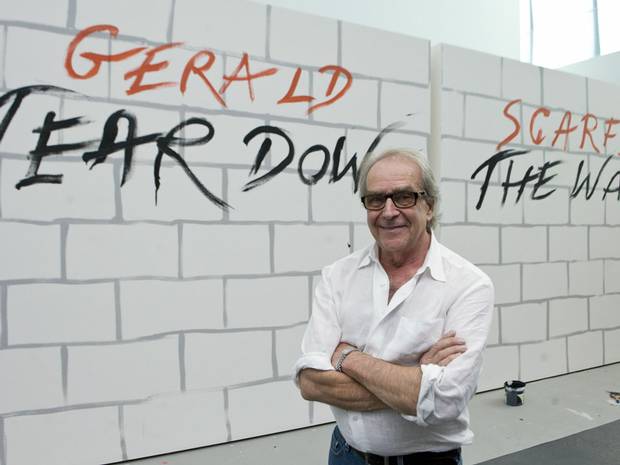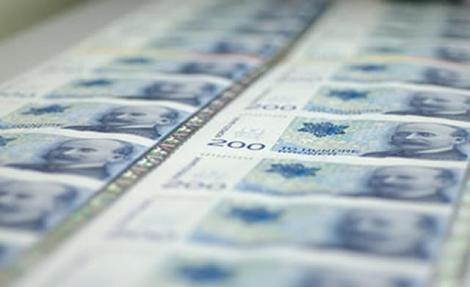The Norwegian prison where inmates are treated like people
Erwin James/ The Guardian, Sunday 24 February 2013
Photograph: Marco Di Lauro
Before he transferred to Bastoy, Petter was in a high-security prison for nearly eight years. “Here, they give us trust and responsibility,” he says. “They treat us like grownups.” I haven’t come here particularly to draw comparisons, but it’s impossible not to consider how politicians and the popular media would react to a similar scenario in Britain.
There are big differences between the two countries, of course. Norway has a population of slightly less than five million, a 12th of the UK’s. It has fewer than 4,000 prisoners; there are around 84,000 in the UK. But what really sets us apart is the Norwegian attitude towards prisoners. Four years ago I was invited into Skien maximum security prison, 20 miles north of Oslo. I had heard stories about Norway’s liberal attitude. In fact, Skien is a concrete fortress as daunting as any prison I have ever experienced and houses some of the most serious law-breakers in the country. Recently it was the temporary residence of Anders Breivik, the man who massacred 77 people in July 2011.
Despite the seriousness of their crimes, however, I found that the loss of liberty was all the punishment they suffered. Cells had televisions, computers, integral showers and sanitation. Some prisoners were segregated for various reasons, but as the majority served their time – anything up to the 21-year maximum sentence (Norway has no death penalty or life sentence) – they were offered education, training and skill-building programmes. Instead of wings and landings they lived in small “pod” communities within the prison, limiting the spread of the corrosive criminal prison subculture that dominates traditionally designed prisons. The teacher explained that all prisons in Norway worked on the same principle, which he believed was the reason the country had, at less than 30%, the lowest reoffending figures in Europe and less than half the rate in the UK.
As the ferry powers through the freezing early-morning fog, Petter tells me he is appealing against his conviction. If it fails he will be on Bastoy until his release date in two years’ time. I ask him what life is like on the island. “You’ll see,” he says. “It’s like living in a village, a community. Everybody has to work. But we have free time so we can do some fishing, or in summer we can swim off the beach. We know we are prisoners but here we feel like people.”
I wasn’t sure what to expect on Bastoy. A number of wide-eyed commentators before me have variously described conditions under which the island’s 115 prisoners live as “cushy”, “luxurious” and, the old chestnut, “like a holiday camp”. I’m sceptical of such media reports.
 An Inmate repairs a bike. Photograph: Marco Di Lauro
An Inmate repairs a bike. Photograph: Marco Di Lauro
As a life prisoner, I spent the first eight years of the 20 I served in a cell with a bed, a chair, a table and a bucket for my toilet. In that time I was caught up in a major riot, trapped in a siege and witnessed regular acts of serious violence. Across the prison estate, several hundred prisoners took their own lives, half a dozen of whom I knew personally – and a number were murdered. Yet the constant refrain from the popular press was that I, too, was living in a “holiday camp”. When in-cell toilets were installed, and a few years later we were given small televisions, the “luxury prison” headlines intensified and for the rest of the time I was in prison, it never really abated.
It always seemed to me while I was in jail that the real prison scandal was the horrendous rate of reoffending among released prisoners. In 2007, 14 prisons in England and Wales had reconvictions rates of more than 70%. At an average cost of £40,000 a year for each prisoner, this amounts to a huge investment in failure – and a total lack of consideration for potential future victims of released prisoners. That’s the reason I’m keen to have a look at what has been hailed as the world’s first “human ecological prison”.
Thorbjorn, a 58-year-old guard who has worked on Bastoy for 17 years, gives me a warm welcome as I step on to dry land. As we walk along the icy, snowbound track that leads to the admin block, he tells me how the prison operates. There are 70 members of staff on the 2.6 sq km island during the day, 35 of whom are uniformed guards. Their main job is to count the prisoners – first thing in the morning, twice during the day at their workplaces, once en masse at a specific assembly point at 5pm, and finally at 11pm, when they are confined to their respective houses. Only four guards remain on the island after 4pm. Thorbjorn points out the small, brightly painted wooden bungalows dotted around the wintry landscape. “These are the houses for the prisoners,” he says. They accommodate up to six people. Every man has his own room and they share kitchen and other facilities. “The idea is they get used to living as they will live when they are released.” Only one meal a day is provided in the dining hall. The men earn the equivalent of £6 a day and are given a food allowance each month of around £70 with which to buy provisions for their self-prepared breakfasts and evening meals from the island’s well-stocked mini-supermarket.
I can see why some people might think such conditions controversial. The common understanding of prison is that it is a place of deprivation and penance rather than domestic comfort.
Prisoners in Norway can apply for a transfer to Bastoy when they have up to five years left of their sentence to serve. Every type of offender, including men convicted of murder or rape, may be accepted, so long as they fit the criteria, the main one being a determination to live a crime-free life on release.
I ask Thorbjorn what work the prisoners do on the island. He tells me about the farm where prisoners tend sheep, cows and chickens, or grow fruit and vegetables. “They grow much of their own food,” he says.
Other jobs are available in the laundry; in the stables looking after the horses that pull the island’s cart transport; in the bicycle repair shop, (many of the prisoners have their own bikes, bought with their own money); on ground maintenance or in the timber workshop. The working day begins at 8.30am and already I can hear the buzz of chainsaws and heavy-duty strimmers. We walk past a group of red phone boxes from where prisoners can call family and friends. A large building to our left is where weekly visits take place, in private family rooms where conjugal relations are allowed.
After the security officer signs me in and takes my mobile, Thorbjorn delivers me to governor Arne Nilsen’s office. “Let me tell you something,” Thorbjorn says before leaving me. “You know, on this island I feel safer than when I walk on the streets in Oslo.”
Through Nilsen’s window I can see the church, the school and the library. Life for the prisoners is as normal as it is possible to be in a prison. It feels rather like a religious commune; there is a sense of peace about the place, although the absence of women (apart from some uniformed guards) and children is noticeable. Nilsen has coined a phrase for his prison: “an arena of developing responsibility.” He pours me a cup of tea.
“In closed prisons we keep them locked up for some years and then let them back out, not having had any real responsibility for working or cooking. In the law, being sent to prison is nothing to do with putting you in a terrible prison to make you suffer. The punishment is that you lose your freedom. If we treat people like animals when they are in prison they are likely to behave like animals. Here we pay attention to you as human beings.”
A clinical psychologist by profession, Nilsen shrugs off any notion that he is running a holiday camp. I sense his frustration. “You don’t change people by power,” he says. “For the victim, the offender is in prison. That is justice. I’m not stupid. I’m a realist. Here I give prisoners respect; this way we teach them to respect others. But we are watching them all the time. It is important that when they are released they are less likely to commit more crimes. That is justice for society.”
The reoffending rate for those released from Bastoy speaks for itself. At just 16%, it is the lowest in Europe. But who are the prisoners on Bastoy? Are they the goodie-goodies of the system?
Hessle is 23 years old and serving 11 years for murder. “It was a revenge killing,” he says. “I wish I had not done it, but now I must pay for my crime.” Slight and fair-haired, he says he has been in and out of penal institutions since he was 15. Drugs have blighted his life and driven his criminality. There are three golden rules on Bastoy: no violence, no alcohol and no drugs. Here, he works in the stables tending the horses and has nearly four years left to serve. How does he see the future? “Now I have no desire for drugs. When I get out I want to live and have a family. Here I am learning to be able to do that.”
 A Convict works on Bastoy prison farm. Photograph: Marco Di Lauro
A Convict works on Bastoy prison farm. Photograph: Marco Di Lauro
Hessle plays the guitar and is rehearsing with other prisoners in the Bastoy Blues Band. Last year they were given permission to attend a music festival as a support act that ZZ Top headlined. Bjorn is the band’s teacher. Once a Bastoy prisoner who served five years for attacking his wife in a “moment of madness”, he now returns once a week to teach guitar. “I know the potential for people here to change,” he says.
Formerly a social researcher, he has formed links with construction companies he previously worked for that have promised to consider employing band members if they can demonstrate reliability and commitment. “This is not just about the music,” he says, “it’s about giving people a chance to prove their worth.”
Sven, another band member, was also convicted of murder, and sentenced to eight years. The 29-year-old was an unemployed labourer before his conviction. He works in the timber yard and is waiting to see if his application to be “house father” in his five-man bungalow is successful. “I like the responsibility,” he says. “Before coming here I never really cared for other people.”
The female guard who introduces me to the band is called Rutchie. “I’m very proud to be a guard here, and my family are very proud of me,” she says. It takes three years to train to be a prison guard in Norway. She looks at me with disbelief when I tell her that in the UK prison officer training is just six weeks. “There is so much to learn about the people who come to prison,” she says. “We need to try to understand how they became criminals, and then help them to change. I’m still learning.”
Finally, I’m introduced to Vidor, who at 72 is the oldest prisoner on the island. He works in the laundry and is the house father of his four-man bungalow. I haven’t asked any of the prisoners about their crimes. The information has been offered voluntarily. Vidor does the same. He tells me he is serving 15 years for double manslaughter. There is a deep sadness in his eyes, even when he smiles. “Killers like me have nowhere to hide,” he says. He tells me that in the aftermath of his crimes he was “on the floor”. He cried a lot at first. “If there was the death penalty I would have said, yes please, take me.” He says he was helped in prison. “They helped me to understand why I did what I did and helped me to live again.” Now he studies philosophy, in particular Nietzsche. “I’m glad they let me come here. It is a healthy place to be. I’ll be 74 when I get out,” he says. “I’ll be happy if I can get to 84, and then just say: ‘Bye-bye.'”
On the ferry back to the mainland I think about what I have seen and heard. Bastoy is no holiday camp. In some ways I feel as if I’ve seen a vision of the future – a penal institution designed to heal rather than harm and to generate hope instead of despair. I believe all societies will always need high-security prisons. But there needs to be a robust filtering procedure along the lines of the Norwegian model, in order that the process is not more damaging than necessary. As Nilsen asserts, justice for society demands that people we release from prison should be less likely to cause further harm or distress to others, and better equipped to live as law-abiding citizens.
It would take much political courage and social confidence to spread the penal philosophy of Bastoy outside Norway, however. In the meantime, I hope the decision-makers of the world take note of the revolution in rehabilitation that is occurring on that tiny island.



